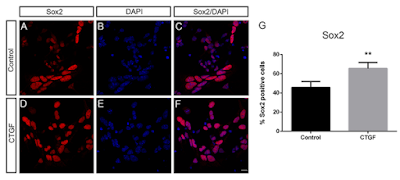Our Human Retinal Microvascular Endothelial Cells in this publication on Diabetic Retinopathy. In this study, the authors show that human retinal microvascular endothelial cells exposed to high levels of glucose regulate miR-200b repression through histone methylation and that inhibition of PRC2 increases miR-200b while reducing VEGF: Michael Anthony Ruiz, Biao Feng, and Subrata Chakrabarti. Polycomb Repressive Complex 2 Regulates MiR-200b in Retinal Endothelial Cells: Potential Relevance in Diabetic Retinopathy. PLoS One. 2015; 10(4): e0123987. Published online 2015 Apr 17. doi: 10.1371/journal.pone.0123987...To investigate PRC2 and miR-200b regulation in the context of diabetic retinopathy, the major cell type used for investigation was the human retinal microvascular endothelial cell (HRMECs,Neuromics/ Olaf Pharmaceuticals, Worchester, MA, Cat# HEC09)...
Figure: High levels of glucose alter VEGF and miR-200b expression in HRMECs.
A: HRMECs exposed to various concentrations of D-glucose for 24 hours exhibited differential mRNA levels of VEGF. Compared to 5mM D-glucose, VEGF expression was significantly increased at 15mM and 25mM D-glucose concentrations, with no change at 20mM L-glucose. B: Measured by WST-1 assay, HRMECs exposed to increasing concentrations of D-glucose for 24 hours exhibited decreased cell viability at 25mM, 50mM and 100mM compared to 5mM. C: HRMECs exposed to 25mM (high glucose; HG) glucose for 24 and 48 hours demonstrated significantly increased VEGF mRNA compared to 5mM (normal glucose; NG). These differences were not observed at time points earlier than 24 hours. D,E: HRMECs exposed to 5mM D-glucose (NG) 25mM D-glucose (HG) and 20mM L-glucose+5mM D-glucose (osmotic control; OSM). HRMECs cultured for 24 hours and 48 hours in HG showed significantly decreased levels of miR-200b with parallel increased levels of VEGF expression compared to NG and OSM. F,G: VEGF is also increased at the protein level in HG compared to NG as measured by Western Blotting. [* p < 0.05 compared to NG; n = 6; data expressed as mean ± SEM, normalized to β-actin or U6 and expressed as a fold change of NG]. doi:10.1371/journal.pone.0123987.
Check out our growing catalog of Human Endothelial Cells-Artery, Microvascular, Vein, Umbilical Cord Derived + Culture Media.








